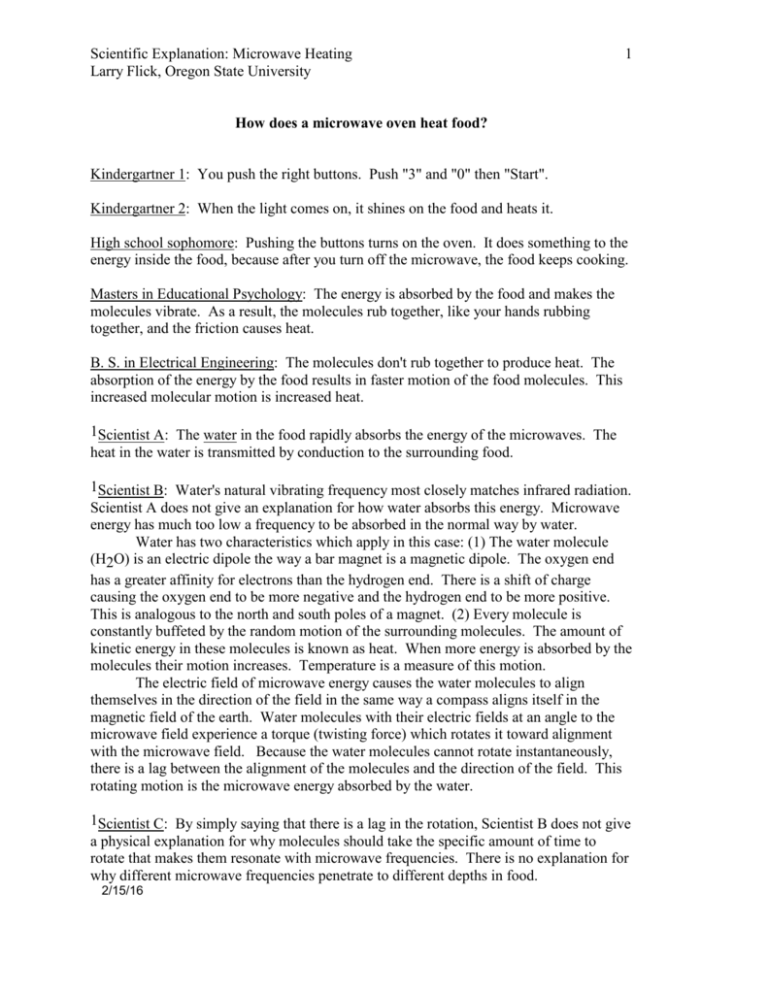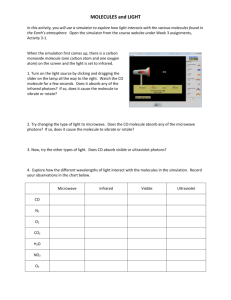How does a microwave oven heat food
advertisement

Scientific Explanation: Microwave Heating Larry Flick, Oregon State University 1 How does a microwave oven heat food? Kindergartner 1: You push the right buttons. Push "3" and "0" then "Start". Kindergartner 2: When the light comes on, it shines on the food and heats it. High school sophomore: Pushing the buttons turns on the oven. It does something to the energy inside the food, because after you turn off the microwave, the food keeps cooking. Masters in Educational Psychology: The energy is absorbed by the food and makes the molecules vibrate. As a result, the molecules rub together, like your hands rubbing together, and the friction causes heat. B. S. in Electrical Engineering: The molecules don't rub together to produce heat. The absorption of the energy by the food results in faster motion of the food molecules. This increased molecular motion is increased heat. 1Scientist A: The water in the food rapidly absorbs the energy of the microwaves. The heat in the water is transmitted by conduction to the surrounding food. 1Scientist B: Water's natural vibrating frequency most closely matches infrared radiation. Scientist A does not give an explanation for how water absorbs this energy. Microwave energy has much too low a frequency to be absorbed in the normal way by water. Water has two characteristics which apply in this case: (1) The water molecule (H2O) is an electric dipole the way a bar magnet is a magnetic dipole. The oxygen end has a greater affinity for electrons than the hydrogen end. There is a shift of charge causing the oxygen end to be more negative and the hydrogen end to be more positive. This is analogous to the north and south poles of a magnet. (2) Every molecule is constantly buffeted by the random motion of the surrounding molecules. The amount of kinetic energy in these molecules is known as heat. When more energy is absorbed by the molecules their motion increases. Temperature is a measure of this motion. The electric field of microwave energy causes the water molecules to align themselves in the direction of the field in the same way a compass aligns itself in the magnetic field of the earth. Water molecules with their electric fields at an angle to the microwave field experience a torque (twisting force) which rotates it toward alignment with the microwave field. Because the water molecules cannot rotate instantaneously, there is a lag between the alignment of the molecules and the direction of the field. This rotating motion is the microwave energy absorbed by the water. 1Scientist C: By simply saying that there is a lag in the rotation, Scientist B does not give a physical explanation for why molecules should take the specific amount of time to rotate that makes them resonate with microwave frequencies. There is no explanation for why different microwave frequencies penetrate to different depths in food. 2/15/16 Scientific Explanation: Microwave Heating Larry Flick, Oregon State University 2 When the water molecule is rotated by the electric field of the microwave it experiences a viscous drag from the surrounding water molecules. This drag is only important in the microwave range of frequencies because below this range the molecules rotate too slowly to experience the drag and above the range the molecules don't rotate at all. At the optimum frequency for generating rotation, all of the absorption is at the surface of the food. The lower the frequency the greater the penetration. The wave propagates faster than the torque, produced by the increasing field, can be applied to the surface molecules. The effect of the drag is to distribute the energy along the path of microwave propagation. 1Scientist D: The twisting molecule model in Scientist C's explanation does not physically explain how the microwave energy is transferred to the random or heat motion of the molecules. The explanation involves the characteristic of water molecules to form groups. The hydrogen end of one molecule is weakly attracted to the oxygen end of another. When such a group is formed, the electrical potential energy between them is reduced. This difference in energy is added to the kinetic energy of the group. This increase in kinetic energy does not raise the temperature of the water since it is balanced by a decrease in kinetic energy when other groups are broken apart by random collisions. There is a dynamic balance between the electrical potential energy and kinetic energy. A microwave adds energy to the random motion if the torque on a molecule breaks one of these groups. Some of the energy to free a molecule from a group comes from the microwaves, so when a free molecule reforms a group the resulting increase in kinetic energy raises the temperature. 1 Walker, Jearl. (1986). The Amateur Scientist: The secret of a microwave oven's rapid cooking action is disclosed. Scientific American, 256(2), February, pp. 134-138. 2/15/16



